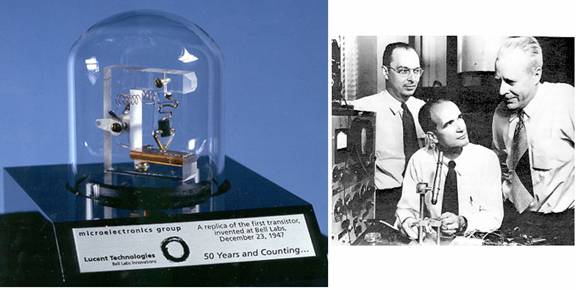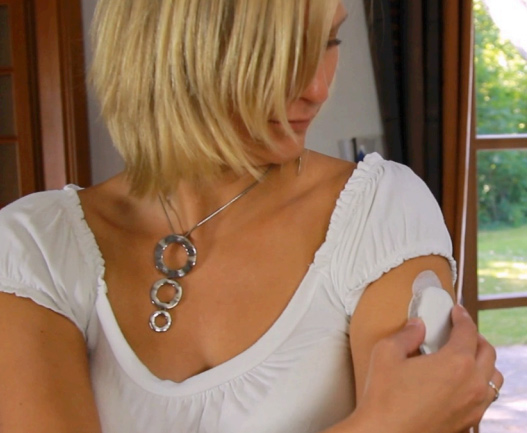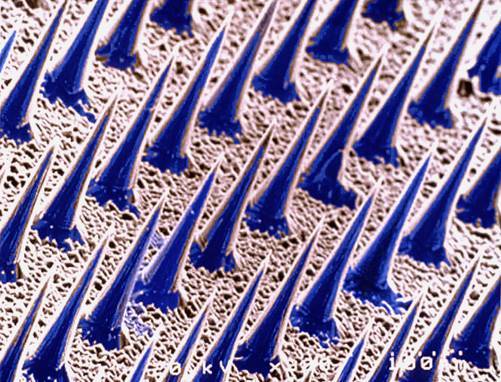The history of implantable technology. MEMS

Microelectromechanical systems ( MEMS ) are a class of miniature devices and systems manufactured using micromachining processes. The main criterion for creating MEMS is their size. Usually it does not exceed 1 mm. MEMS technologies are the forerunner of a relatively more popular area of technology, where the size of devices starts from 100 nanometers.
Initially, the term MEMS was coined to refer to miniature sensors and actuators operating between the electrical and mechanical areas of the device. Gradually, the term evolved along with MEMS themselves and encompassed a wide range of various microdevices made using micromechanical processing.
')
Similarly, the term " biomedical microelectromechanical systems " is used to refer to the science and technology of production of micro-devices for biological and medical applications. These include biomedical sensors, implants, microsurgical instruments and other devices.
The invention of a point transistor by William Shockley , John Bardeen and Walter Brattein in 1947 gave impetus to the creation of MEMS. The first transistor was about the size of 1.3 centimeters, which is much larger than the current. Modern technology allows you to create transistors with a diameter of about 1 nanometer.

In 1954, K.S. Smith discovered and described a piezoresistive effect — a change in the electrical resistance of a semiconductor or metal under the influence of a mechanical load. In contrast to the piezoelectric effect, the piezoresistive effect causes changes only in the electrical resistance, and not in the electrical potential.
As a result of the experiments, it became clear that silicon and germanium are more sensitive to air or water pressure than metals. Many MEMS devices, such as strain gauges, pressure sensors, and accelerometers, use a piezoresistive effect in silicon.
The discovery of this effect in semiconductors resulted in the beginning of the industrial production of silicon-based pressure sensors. In 1959, the company Kulite first put their production on stream.
When creating transistors, engineers faced size limitations. Each transistor had to be wired to the rest of the electronics. Then there was a need for something that could accommodate transistors, resistors, capacitors and connecting wires. One such substrate would allow the creation of miniature devices.
So in 1958, two people - Jack Kilby from the American company Texas Instruments and Robert Noiz from Fairchild Semiconductor independently of each other - assembled an integrated circuit. The Kilby circuit consisted of a transistor, three resistors and one capacitance on a germanium crystal - the so-called “solid circuit”. The Noise scheme was called “unitary” and was made on a silicon crystal.

Kilby Scheme
In 1964, Westinghouse Electric assembled the first production MEMS. In the device, which was called a resonant gate transistor, mechanical and electronic components were assembled. The transistor worked as a kind of frequency filter - passed electric signals of a certain range.
The first commercial application of MEMS was not long in coming: in the 70s, Kurt Peterson from the IBM laboratory assembled a micromechanical pressure sensor, which found use in blood pressure sensors.
In 1993, the company Analog Devices became the first mass-produced accelerometers MEMS. Most of them were used in the automotive industry, but over the years their field of application has expanded to autonomous navigation systems, game controllers, as well as mobile and computer systems.
MEMS Technology Applications
In the early years of its existence, the MEMS technology turned out to be revolutionary for many fields of science, including mechanics, acoustics, optics, and others. Over time, unique solutions and products appeared in the chemical, biological and medical field. MEMS penetrated household appliances and electronics, automotive, biomedical and aerospace industries.
Pressure Sensors
The first microelectromechanical devices that were used in the biomedical industry in the 1980s were reusable blood pressure sensors. Modern MEMS pressure sensors measure intraocular, intracranial, intrauterine pressure, and are also used during angioplasty.
According to the WHO, glaucoma is the second most common cause of blindness after cataracts. Implantable pressure sensors allow continuous monitoring of intraocular pressure in patients with glaucoma. In a healthy eye, pressure is maintained in the range of 10-22 mm Hg. Abnormally high pressure (> 22 mm) and its fluctuations are considered as the main risk factors for the development of glaucoma.
This disease often occurs without any noticeable symptoms and pain, but can lead to irreversible and incurable damage to the optic nerve. Without timely treatment, peripheral vision suffers and sometimes complete blindness occurs.
One of the sensors measuring IOP is shown below. It is a disposable contact lens with an element of the pressure sensor MEMS. The sensor includes an antenna loop (gold ring), a special purpose microprocessor — a 2x2 mm chip, and strain gages for measuring the curvature of the cornea in response to changes in intraocular pressure. The antenna loop is powered by an external monitoring system and transmits the information back to the system.

Inertial sensors
MEMS accelerometers are used in defibrillators and pacemakers. Patients suffering from heart palpitations or a chaotic heartbeat are often at greatest risk of cardiac arrest or heart attack.

A pacemaker maintains a normal heartbeat by transmitting electrical impulses to the heart. Modern devices use MEMS accelerometers that regulate the heart rate in accordance with the physical activity of the patient.
In addition, inertial MEMS sensors - accelerometers and gyroscopes - were used to develop one of the most unusual wheelchairs iBOT Mobility System. The combination of several sensors allows the user to control the wheelchair and adjust the height of the chair, forcing the wheelchair to balance on two wheels. Thus, a person in a wheelchair can interact with other people face to face.

Measuring transducers
Measuring transducers are used in hearing aids. These electroacoustic devices are used to receive, amplify and direct sound into the ear. In this way, hearing aids compensate for hearing loss and make audio signals more visible to the user.
According to statistics, 80% of people with partial or complete hearing loss do not install hearing aids. The reasons are often the reluctance to recognize hearing loss and social stereotypes associated with delusions about wearing hearing aids. Following this data, many manufacturers invest their strength and money in miniaturization of devices, which at the same time did not go to the detriment of productivity.

MEMS technology can reduce the form factor, cost and power consumption compared to traditional solutions. For example, Analog Devices, whose volume is only 7.3 mm3, includes a MEMS microphone, suitable as a hearing aid.
Microhydrodynamic systems
Microhydrodynamics is a field of scientific knowledge that addresses the behavior of small volumes and fluid flows. A typical microhydrodynamic system consists of: needles, channels, valves, pumps, mixers, filters, sensors, and tanks.
Such systems are often used to conduct medical tests at the bedside. Such tests and analyzes play a special role in developing countries where access to hospitals is limited and treatment is expensive. Diagnostic microhydrodynamic systems use body fluids (saliva, blood, or urine samples) to pretreat a sample for analysis, to find the desired component in a sample of a substance, and also to analyze data and display the results. One of the most widely known and widespread micro-hydrodynamic systems is the pregnancy test.
In addition, these systems are used to deliver drugs to a specific human organ. So, with the help of microneedles, percutaneous delivery of drugs is carried out. There are still implantable delivery systems (insulin pump, stents with drugs) and directly means of drug delivery (micro- and nanoparticles).
For patients with diabetes in 2012, a special insulin delivery system was developed - JewelPUMP. The first version was installed on a disposable skin patch and provided a continuous supply of insulin to the human body. The entire system weighed only 25 grams and contained up to 5,000 units of insulin, which lasted for 7 days without additional replenishment or replacement.

Micromechanical needles
Modern micro-processing technologies allow the manufacture of needles with a size of less than 300 microns, which is the limit of traditional processing methods. As a rule, the length of the MEMS microneedle is less than 1 mm. They are used for drug delivery, biomedical signal recording, fluid sampling, cancer therapy and microdialysis.
Often these microneedles integrate into any device and are used in combination with microchannel systems. Solid and hollow microneedles are made using micromachining of silicon, glass, metals and polymers. They come in various shapes - from cylindrical to octagonal.

Solid microneedle manufactured by the method of reactive ion etching of silicon.
Microsurgical instruments
A minimally invasive surgical procedure is designed to diagnose, monitor, or cure diseases by performing operations with very small incisions or even through natural holes in the human body. The advantages of such surgery over traditional open surgery are less pain, minimal tissue damage and the number of scars, quick recovery after surgery, and often lower cost to the patient.
Common procedures for minimally invasive surgery include angioplasty, catheterization, endoscopy, laparoscopy and neurosurgery. MEMS-based microsurgical instruments are the most appropriate technologies for minimally invasive surgery.
So for the procedure of angioplasty, designed to restore normal blood flow through blocked arteries, heart stents are used. They are introduced into a blood vessel through a catheter to expand the vessel. There are two main types of stents: metal and polymer stents Polymer, in turn, are divided into absorbable and non-absorbable. Obviously, the former are more attractive because they can dissolve inside the body after they fulfill their purpose.
More than 50 years have passed since the first mass production of MEMS. During this time, the technology of biomedical MEMS has firmly entered our lives: with its help, it has become possible to help people with disabilities, to treat serious diseases and to perform safe surgical operations. The technology continues to actively develop thanks to the creation and discovery of new materials, which makes it possible to reduce the size of MEMS and thereby expand the scope of their application.
Source: https://habr.com/ru/post/401817/
All Articles